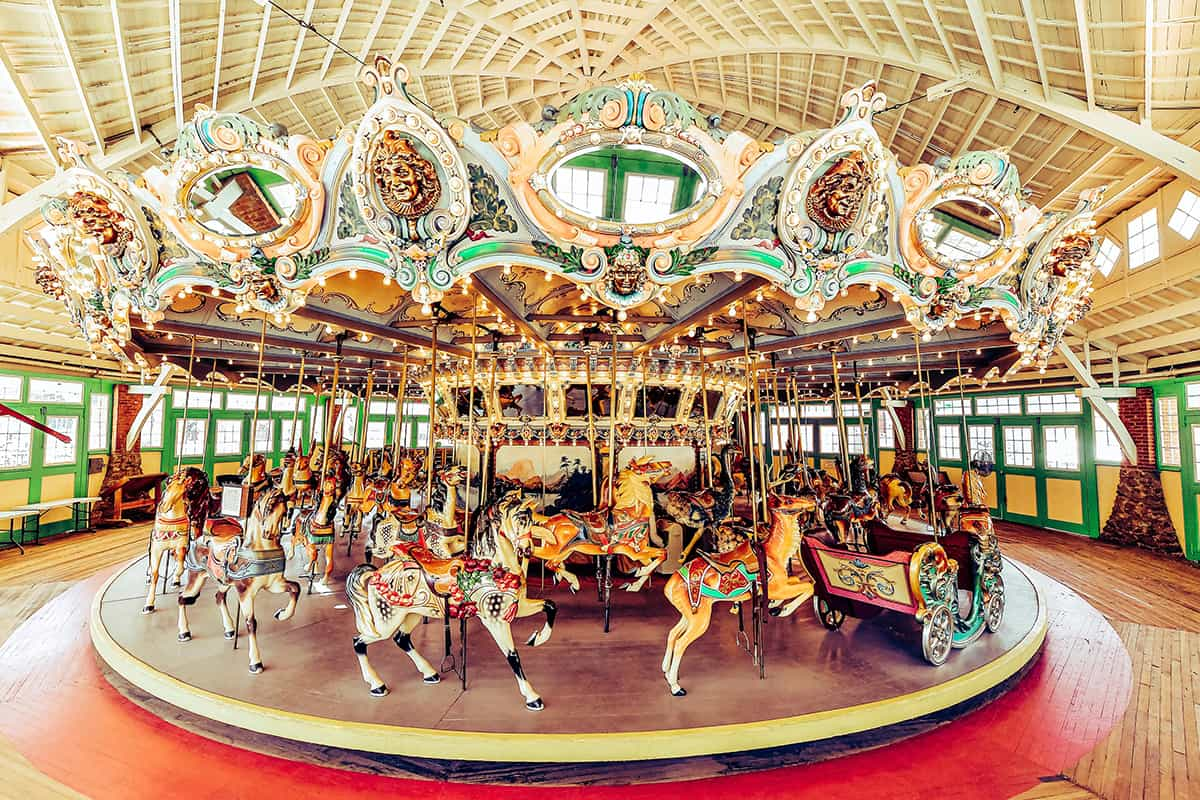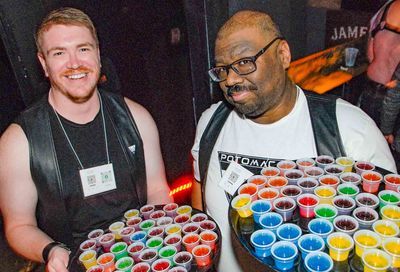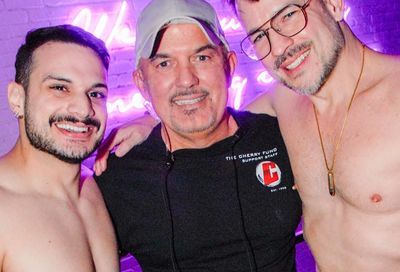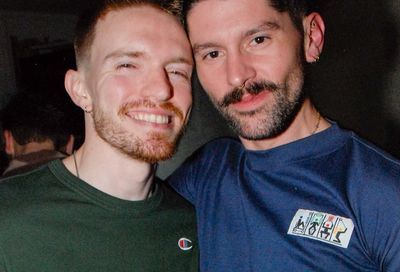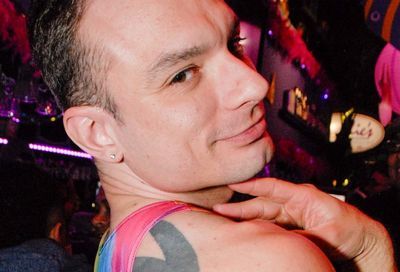Mind Frak: How Michael Carbonaro magically messes with people’s heads
The Carbonaro Effect crafts amazing illusions out of real life moments

“I think what people like to see — because I certainly know I do — is to see somebody have this little private moment where they see something happen,” says Michael Carbonaro. “And you literally watch the gears going, watching somebody trying to process an impossible moment where something solid penetrates through something else. And they’re sitting there and their eyes are going, ‘What?’ You watch those gears going and you watch the person wrestle between reality and fantasy.”
In illusions both large and small, the 42-year-old constantly throws unsuspecting subjects into moments of mental turmoil on “hidden camera magic TV show” The Carbonaro Effect, entering its third season on cable network truTV. It’s an immensely entertaining — and incredibly addictive — twist to the hidden camera shenanigans of Candid Camera, pioneered by television legend Alan Funt in the late 1940s. Unlike most hidden camera shows, which simply prank the viewer, the addition of an actual magical illusion — the impossible, the improbable, the brazen — to the formula adds a layer of unexpected psychological depth, as Carbonaro Effect often detours into the cause and effect of human behavior.
Witness, for example, a segment from the season premiere, in which an increasingly shell-shocked woman is made to believe she’s on the wrong side of a train platform. It’s a mind-blowing illusion for both her and us. Where it gets interesting, however, is in her reaction. Feeling she is in error, she crosses over to what she believes to be the correct platform — only to find she’s still on the wrong side. So, she takes a breath and crosses back. When it’s revealed by a deviously grinning Carbonaro that she’s been had, her elation at realizing that she’s not barking mad is immensely cathartic.
The show wouldn’t work as well as it does if it weren’t for its host. In addition to being a skilled illusionist, Carbonaro, like all the best magicians, is a congenial, affable con artist. He’s got a face — and a handsome one at that — people trust.
That handsome face was on display in one of the biggest gay comedies of the mid-2000s: Another Gay Movie, a balls-out parody of the straight comedy American Pie. In AGM, Carbonaro, himself an out gay man, starred as Andy, a ceaselessly horny gay teenager who takes a liking to fruits and vegetables.
“I remember thinking to myself [that taking this role] might put me down a direction I’ll never be able to back out of,” he says of the decade old comedy. “I won’t ever get to be on the Disney Channel or I’ll never get to do a family-oriented show because this is going to be too….” He trails off. “You know, I was scared,” he says, finally.
Carbonaro overcame that fear at the urging of his agent. It turned out to be a good move, career-wise.
“I think that I probably wouldn’t have this TV show if I wasn’t that guy that decided to move forward with those kinds of daring, scary projects,” he says, “because what I’m doing right now is no less scary and in the world of the unknown than that was.”
As with all conversations nowadays, talk eventually turns to the political rip-tide that is defining the new Trump administration. Carbonaro’s response is hardly surprising.
“I’m terrified. I’m appalled. I’m nervous for all of us,” he says. “But I’m overjoyed and feel a lot of hope when I see the marches and people standing up. When you look at the numbers and you know what’s really going on, there’s an amount of positivity to know that the human spirit is still glowing strong from both sides. I’m frightened, but ready to stand up and fight along with my people.”
Asked if, as a magician, he could help the cause by making Trump just vanish — not in a bad way, maybe just be inconveniently transported to the Arctic, or the moon — Carbonaro chuckles.
“I’m not at liberty to disclose that information at this time.”

METRO WEEKLY: Let’s start with the magic. What led you to becoming a magician?
MICHAEL CARBONARO: As a child, I wanted to become a special effects artist. That was really my first passion. I loved Halloween and monsters and special effects and horror movies — because, you know, special effects are kind of like magic. As a 13-year-old kid growing up in Long Island, New York, I used to buy makeup supplies at a local magic shop. It’s funny that special effects and magic are in the same store — special effects, magic, costumes, pranks, jokes, gags, masquerades, all that stuff. When shopping for makeup I was suddenly going, “Wow, those guys behind the counter are doing some really cool tricks,” and I started loving it and wanting to perform them myself.
There was a love of performance in magic that I found. I like talking to people and I like making people laugh and I like putting the coin in their hand and having it disappear and watching their face. I like having that experience, that interaction with someone. I found my way into being an entertainer through magic. I really saw myself as a performer through magic.
MW: Do you remember the first trick you ever performed?
CARBONARO: Yes. I was watching, with my family, [David] Copperfield on television. I think it was the night he was going to walk through the Great Wall of China. It was a huge, epic event that we were all like, “Is this man really doing that?” He had a real mystery to it and I really got hooked on his TV show, because he’s just the master perfectionist. Everything is so clean and perfectly executed and smart and tight and fun.
So I remember that night when we watched that show as a family, I went up to my room and grabbed some of my art stuff. I came downstairs, took a piece of paper and scribbled all over it in front of my mom and dad. I tore up the paper and folded it up and then unfolded it and the paper was back together. I made up how to do it — and a version of that trick is still in my live show. But I just remembered their faces. They were completely fooled. There was an electricity like, “How did you do that?” I was hooked.
MW: You don’t rely on old magic standards on The Carbonaro Effect, though there are sometimes variations. Do you consider yourself an inventor of sorts?
CARBONARO: Yeah, there’s a hands-on kind of inventor’s mentality to magic. But do I have an inventor’s mind? I think that’s where the special effects artist in me is engaged. I’m very artistic. I can sculpt really well. I can paint really well. I can make things. Sometimes, in magic, a lot of things that look normal are highly engineered and have some trickery to them. Sometimes you have to make a pencil look like a pencil when there might have something else going on. Just being able to create those things artistically and magically is under that umbrella of effects.
I’ve got an incredible team of magicians who work on The Carbonaro Effect — friends of mine, some that I’ve known since I was a kid at Tannen’s Magic Camp, and some who I’ve met in Los Angeles at the Magic Castle and through the Academy of Magical Arts. Really great friends. Some magicians like performing, and some magicians don’t, but they love inventing. They have this engineer’s mind for coming up with gimmicks and methods. I think I playfully rest somewhere in the middle, probably more on the performance side, which is good for what I do.
I have David Regal. I have Michael Webber and Derek DelGaudio, Darren Berger, Matt Schick, Chad Sanborn. I’ve got friends in the business. Copperfield has really taken a liking to the work I’m doing and I’ve gotten to know him. Penn & Teller are my friends. Johnny Thompson and Tom Redino, who are inventors and magicians in Las Vegas who create elaborate illusions for Penn & Teller and the likes, have created some illusions together [for us]. Johnny Thompson is kind of the godfather of magic. He’s the guy that knows where everything comes from and who made it up first and how you can combine this method with that. Johnny Thompson is one of those guys that I would call up and say, “Hey, do you know how to make an elephant disappear.”
I wanted to do a trick in the show where a security guard is watching over a car and the car is completely surrounded by velvet ropes and it can’t go anywhere and while the guard’s looking over it, I come over with a winning ticket, but before he knows it, the car that we’re both talking about suddenly vanishes.” I’m like, “I want to make a car vanish from inside of the dealership. How do I do that?” And Johnny Thompson says, “Well, you don’t.” I was like, “Oh.” He’s like, “What you can do is make the car vanish from a tent enclosure, completely surrounded and we could even do it outside on solid pavement.”

MW: I’ve never understood how magicians do that kind of trick. There are some things that defy explanation.
CARBONARO: As they should. Magic is a perspective art. It’s funny because when you watch the show, you see this lone man standing by himself engaging usually with one or a couple of people. But we’ve got a crew of thirty people hiding behind the screens and stuff, with the cameras behind two-way mirrors. There’s a truck outside with monitors, with crew watching over it, making sure we can hear everything on our hidden microphones and making sure we can see everything. It’s elaborate. As most things are, it’s a complicated road to simple.
Every person that comes in there and is fooled on The Carbonaro Effect is an unsuspecting person, not an actor. They do not know they are going to be fooled — and they are really fooled by real methods of magic. I’m very judicious with the way I edit the show. You have to cut from one camera to another so you can see the guy’s face and you can see the trick and you can see me. It’s a very complicated equation because at any given time, seven cameras are rolling and six of them might be exposing the trick. With magic, you have to be a master of perspective.
I think The Carbonaro Effect would be just as entertaining — or entertaining in a different way, but just as entertaining — if I exposed all the tricks. If the home viewer saw how the tricks were done, it would still be really fun to watch the person go through that experience. But that’s just not the show that I’m doing. I like the viewer to be in this weird zone where they’re on my team because they know that we together are fooling this unsuspecting person, but then they also get to go, “How is he doing that?”
MW: These are live tricks? Live people, live reactions, live tricks. There’s no artifice in terms of doing clever editing in which you might stop the camera at any point to rig the trick?
CARBONARO: Absolutely not. Never, no way. No way. We don’t do that. That’s immoral.
I’m on a live tour right now with 40 dates in different cities across the nation and these diehard fans of the show are coming. They have that question in their minds, just like you said. They’re like, “If I’m sitting right here in the front row and Michael Carbonaro comes out on stage, is he going to be able to make something appear out of nowhere?” And the answer is yes. It’s really exciting for them to come to the live show and see that happen.
MW: One trick that really blew me out of the water is in the third season premiere, the one with the girl on the train platform.
CARBONARO: Oh good, you saw that one.
MW: Oh, my God. Her reaction was priceless. If that had happened to me, I’d probably be in tears.
CARBONARO: What we did on the train platform was really incredible, because a lot of times on the TV show, I’ll teleport. People are always asking, “Do you have a twin,” because we’ve done a lot of effects on the show where I’ll be locked inside of a car and then suddenly I’m inside a hotel room or I’ll climb up a ladder and then suddenly the person turns around and I’m right behind them again. But with the train platform, an unsuspecting person has suddenly teleported themselves and they’re not where they thought they were. I can’t believe we pulled that off. I think you’re right — I would probably be in tears if that happened to me, too.
MW: I’m surprised she didn’t have a nervous breakdown.
CARBONARO: You really just watch her short circuit there. You’re messing with somebody. You’re stepping in and throwing a wrench into somebody’s reality. But people really like it. There’s a good heartedness behind it that kind of reminds me of, say, Bugs Bunny. I’m almost a Bugs Bunny character that walks up to somebody, messes with reality for a second, and just watches the outcome.

MW: In the same episode, there’s a great trick utilizing a statue of Abe Lincoln. There was one bit with the statue’s hat that I was able to half figure out. I say half because, I still couldn’t figure out how you actually achieved it.
CARBONARO: The recipe for the best kind of an illusion is to have layers like that. You have to stack it. It can’t be one secret. It’s got to be like five secrets so that you’re lost. Five little secrets will make a much more powerful illusion than one good secret.
MW: Let’s talk a bit about your life as a gay man.
CARBONARO: I always knew I was gay growing up. It was never like a discovery. I knew what gay was but I didn’t think I was gay because I had learned that the word “gay” was a bad word. It’s like “gay” was a bad person or a perverted person or they’re dirty and gross and weird and bizarre and freakish. I’m like, “Well I’m not that.” So I knew I wasn’t that, but I knew I liked other guys. I always did.
When I nostalgically look back on it, thinking to myself, I was instinctively learning that the world does not work the way everyone says it does. There’s this American Dream — get married, have kids — that’s how the world works and that’s how it goes. But I’m thinking, “Uh, that’s not exactly what I think is going on here.” I had this vision outside of things a little bit. The world is bigger and different than everybody’s saying it is, or I’ve got to find my own path. That informed a lot of the kind of work that I do as an artist.
MW: Do you think your audience is aware, by and large, that you’re a gay man?
CARBONARO: I think so. But do I think anybody goes, “Have you seen that gay magician who does the hidden camera thing?” I don’t think that that’s a part of the equation. I think it’s, “Did you see that funny show?” So I don’t know if it’s in their consciousness completely. But I do want them to be aware of it. I read something once where they were describing the show and they literally said, “In his show, Michael Carbonaro is an openly gay magician who tricks unsuspecting people in public.” When you hear that sentence, it’s like “Wait, what is it? He’s an openly gay magician who tricks unsuspecting people in public? It sounds like some sort of bizarre kidnapping situation. I don’t know what’s happening there, but I’m not watching that show.” But that’s not the show. The show’s about a magician who’s pretending not to be a magician.
MW: In that sense, you’re a closeted magician.
CARBONARO: [Laughs.] Exactly. You’re exactly right. Openly gay, yet closeted as a magician.
MW: How is LGBTQ acceptance within the magic industry?
CARBONARO: Good question. I’d say it’s somewhere in the middle of theater and television. It’s not exactly as accepting and open as theater, but it’s — I don’t know. We’re magicians. We’re used to secrets.
The Carbonaro Effect airs Wednesdays at 10 p.m. Eastern, 9 p.m. Central on truTV. Check your local cable listings or visit truTV.com.
Support Metro Weekly’s Journalism
These are challenging times for news organizations. And yet it’s crucial we stay active and provide vital resources and information to both our local readers and the world. So won’t you please take a moment and consider supporting Metro Weekly with a membership? For as little as $5 a month, you can help ensure Metro Weekly magazine and MetroWeekly.com remain free, viable resources as we provide the best, most diverse, culturally-resonant LGBTQ coverage in both the D.C. region and around the world. Memberships come with exclusive perks and discounts, your own personal digital delivery of each week’s magazine (and an archive), access to our Member's Lounge when it launches this fall, and exclusive members-only items like Metro Weekly Membership Mugs and Tote Bags! Check out all our membership levels here and please join us today!




